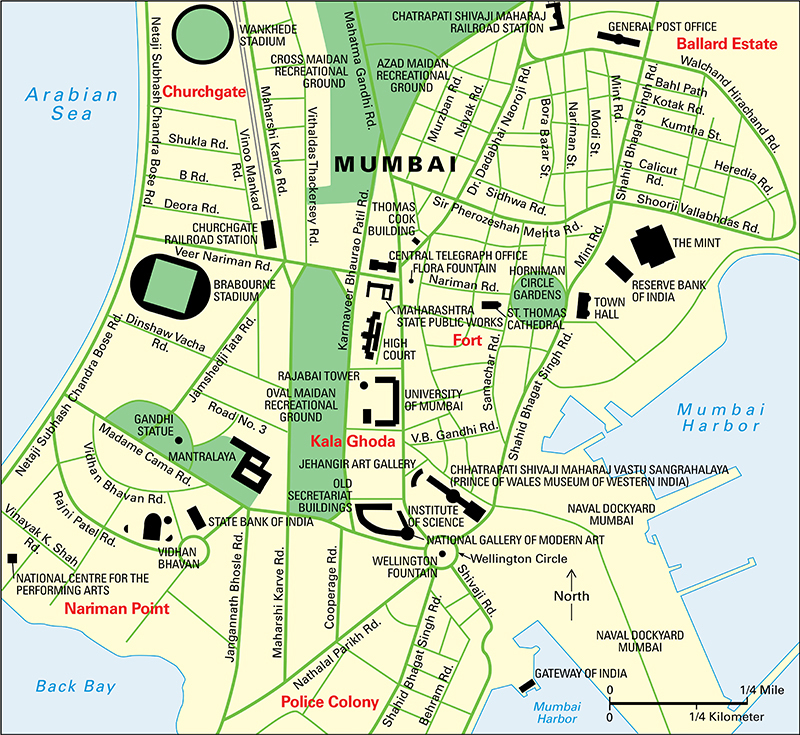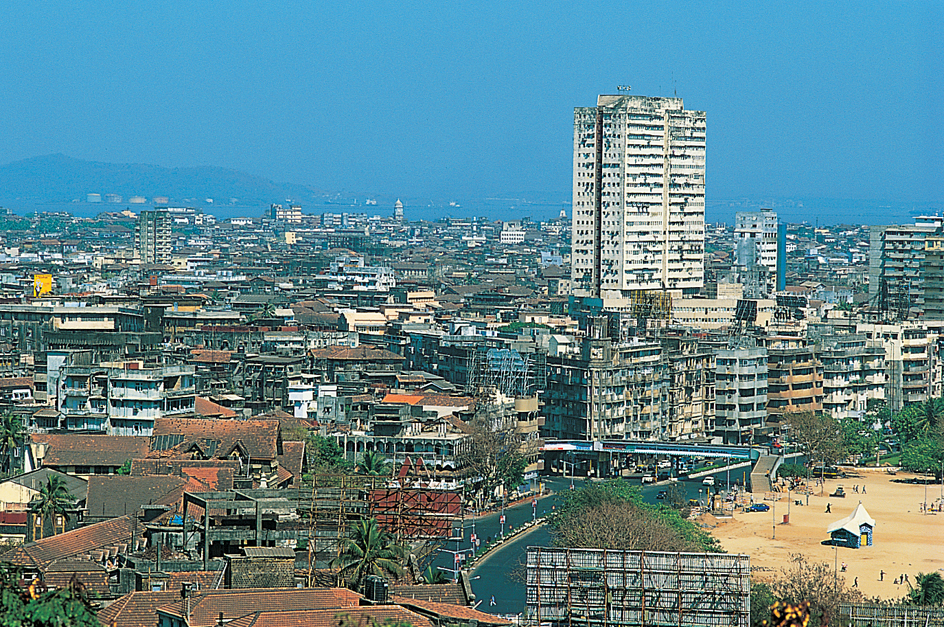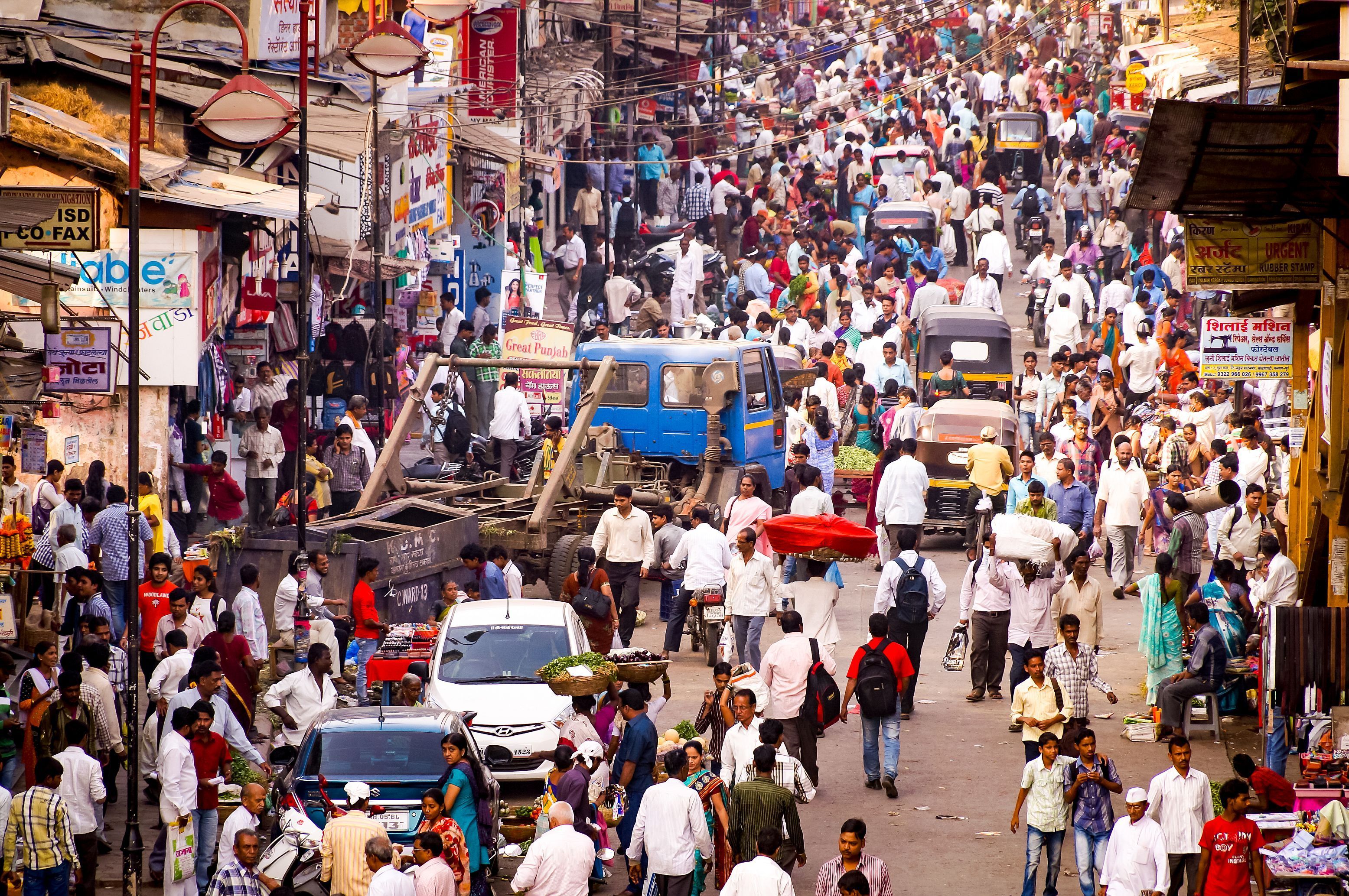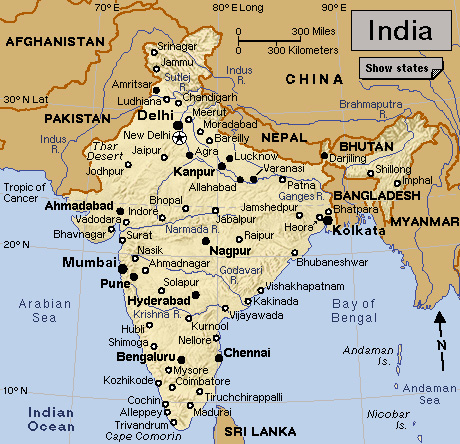Mumbai, << mum BY >> (pop. 12,442,373; met. area pop. 18,414,288), is the largest city in India and the capital of Maharashtra state. The city is often called by its former official name, Bombay.

Mumbai has been India’s chief western seaport since the 1700’s, and has been called the Gateway to Asia. It is also an important financial center, the home of India’s diamond-cutting industry, and the heart of the Indian film industry.
Mumbai is built on a group of islands, joined by causeways and breakwaters, lying off the Konkan coast. On the western side of the city is the broad sweep of the harbor, which is dotted with islands. Inland, the city is framed by the backdrop of the Western Ghats mountain chain. Bridges link Mumbai with the mainland. To help ease overcrowding, the government of Maharashtra has developed a commercial, industrial, and residential area called New Mumbai. Known locally as Navi Mumbai, this area is on the mainland near Mumbai.
The city
The group of islands that make up Mumbai Island is linked to the mainland by the larger island of Salsette. The city lies on low, flat land, a quarter of which is below sea level. On either side are low hills. The eastern hills end in Nariman Point, a headland that protects Mumbai Harbour from the sea. At the end of the western hills is Malabar Hill which, at only 180 feet (55 meters) above sea level, is the city’s highest point.

The old heart of the city was the Fort, on a low rise between the harbor and Back Bay. This area is now the city’s business quarter. Most of the city’s chief buildings, hotels, museums, cinemas, and schools are in the older part of Mumbai. The newer, industrialized section called Greater Mumbai lies in the north. It covers an area of 233 square miles (603 square kilometers), which is about 10 times the size of the old city.
Much of Mumbai is modern. There are large areas of crowded slums. But the city also has some of India’s most luxurious housing. It is noted for its shops and restaurants. The city race course is named after Mahalaxmi, a goddess of good fortune and wealth, whose temple stands nearby at the water’s edge.
Buildings.
One of the most famous landmarks in Mumbai is the Gateway of India. This huge arch commemorates the visit to India in 1911 of King George V of the United Kingdom. The original white plaster design was replaced in 1927 by an arch of yellow stone in a mixture of Gujarati, Islamic, and European architectural styles. Public buildings in Western neoclassical style include the Mint and the Town Hall. But Mumbai is most famed for its Indian-style Gothic buildings, such as the Central Telegraph Office, High Court, General Post Office, and Chatrapati Shivaji Maharaj railroad station (formerly the Victoria Terminus). These buildings were constructed during the city’s boom period of the 1860’s to 1880’s. Many of them are decorated with carvings, including birds and animals, made by Indian craftworkers.

People.
Like other Indian cities, Mumbai has grown rapidly since the 1800’s. This growth in modern times has been caused mostly by the arrival of migrant workers. Mumbai’s birthrate is lower than the Indian average.

Education and cultural life.
Mumbai has a literacy rate much higher than the Indian average. Primary education is free in state-run schools. The University of Mumbai was founded in 1857. It is made up of more than 130 colleges. The city also has the Indian Institute of Technology and the Tata Institute of Fundamental Research. Museums include the Jehangir Art Gallery and the Chhatrapati Shivaji Maharaj Vastu Sangrahalaya, formerly the Prince of Wales Museum of Western India, which has collections of art, archaeology, and natural history.
For recreation, Mumbai’s citizens enjoy the resort of Krishnagiri Upavan. Parks and public gardens include Jijamata Udyan, Baptista Garden, Pherozeshah Mehta Gardens, and Kamala Nehru Park. Sports facilities include Brabourne Stadium for soccer and hockey, Wankhede Stadium for cricket, and Valhbhai Patel Stadium for athletics and cycling. Sunbathing is popular at the many beaches, which stretch across the city’s western edge, separated from each other by inlets and creeks. They include beaches such as Chowpatty, Juhu, Marve, and Gorai. Cinemas are also popular.
India’s motion-picture industry began in Mumbai. The industry has grown to become one of the largest in the world and is known as Bollywood. Films and film stars have helped establish Mumbai as a city with a reputation for style, bustle, and an extravagant social scene. See Bollywood.
Religion and language.
Mumbai has a mixed population in terms of both religion and language. Hindus make up the single largest religious community. There are also large Muslim, Christian, and Sikh communities. In addition, the city has groups of Buddhists, Jains, and Jews.
One of the most important of the minority religious groups is the Parsis, also spelled Parsees (see Parsis). They first settled in Bombay in the 1670’s. They were pioneers in adopting Western ways, playing cricket and sending their sons to British universities. A Parsi, Jeejibhoy Jamshedji Tata (1783-1859), was the first Indian to be made a British baronet.
The main local language is Marathi, the official language of the state of Maharashtra. Gujarati and Hindi are also widely spoken (see India, Languages of). Almost every other major Indian language can be heard in Mumbai, as well as Arabic, Chinese, and English. Newspapers are printed in English, Marathi, Hindi, Gujarati, Urdu, and Sindhi.
Economy.
Mumbai is the most important economic center in India. It has almost half the country’s textile mills. It also has one-sixth of India’s factories. For hundreds of years, Mumbai has been a major Asian port. It handles half of India’s foreign trade. The city has India’s largest stock exchange, and the Mint. Also based in the city are some leading insurance companies and the headquarters of India’s Atomic Energy Commission.
Tourism is growing in importance. Mumbai has a lively night life, with discos, theaters, restaurants, and hundreds of cinemas. The city is regarded as India’s best shopping center, noted especially for embroidered textiles, silverware, diamonds, and leather goods.
Industry.
The city’s prosperity developed in the 1800’s from the manufacture of cotton textiles. This industry is still important. Other major industries or products include engineering, electronics, plastics, foods, fertilizers, metal processing, vehicles, chemicals and paints, and printing.
Transportation.
Mumbai is the hub of the western and central regions of India’s railroad system. Chhatrapati Shivaji Maharaj International Airport, on Salsette Island, handles domestic and international flights. As well as being India’s leading west coast port, Mumbai is the western base for the Indian Navy. Public transport within the metropolitan area is provided by electrified railroads, municipally run buses, and a monorail system.
Government.
As the state capital of Maharashtra, Mumbai is the home of the state governor, and the site of the state Legislative Assembly. Some services, including posts and telegraphs, railroads, airports, and the port, are controlled by the Indian government. The state of Maharashtra provides some of the city’s electric power supply and hospitals, and supervises secondary education. Most other services are run by the municipal corporation of Greater Mumbai. The corporation’s assembly is elected every four years. The state government appoints a chief executive, who serves a three-year term. The mayor is elected each year by the corporation, but has no real power.

History
Stone Age tools have been found at Kandivli, in Greater Mumbai. Later inhabitants of the area were a fishing people called the Kolis.
In the 200’s B.C., the area was within the empire of Ashoka. From the 500’s to 800’s A.D., it was ruled by the Chalukya dynasty. After the Chalukyas, Silahara chiefs from the Konkan coast ruled from the 800’s to 1200’s. At the same period, rulers called the Yadavas (1187-1318) established themselves on Mumbai Island. Most of the place-names on the island date from this era. In 1348, invaders conquered the Mumbai region, which became part of the kingdom of Gujarat.
In 1534, Bahadur Shah, the sultan (local ruler) of Gujarat, gave the islands to the Portuguese. Britain obtained Bombay in 1661, as part of the marriage settlement between King Charles II of Britain and Catherine of Braganza, sister of the king of Portugal. In 1668, the British government handed over Bombay to the East India Company (see East India Company).
Bombay began to grow rapidly under Gerald Aungier, who was British governor from 1669 to 1677. He set up a militia, and welcomed traders and craftworkers. By 1800 Bombay’s population had reached 120,000.
In the 1800’s, Bombay’s development was helped by the abolition of the East India Company’s trade monopoly in 1813, the coming of steam ships, and the opening of a railroad, the first in Asia, in 1853. By 1850, Bombay’s population had risen to more than 500,000. The first textile mill began working in 1857 and by 1860 Bombay was an important center of the cotton trade. During the American Civil War (1861-1865), a Union blockade prevented the Southern States from exporting cotton to the United Kingdom. Indian merchants seized the opportunity, and Bombay became the world’s chief cotton market.
Imposing new buildings were built in the 1860’s during the governorship of Sir Bartle Frere. The opening of the Suez Canal in 1869 also boosted Bombay’s overseas trade. New docks were built, but there was also a rapid growth of slums and disease caused by overcrowding and poor housing.
Bombay was a center for nationalist political activity. In 1885, the first session of the Indian National Congress was held in the city. It was this movement that eventually won Indian independence from British colonial rule.
During World War II (1939-1945), Bombay’s port handled many Allied ships. In 1948, a seawall enclosing more than 1,235 acres (500 hectares) was completed. The wall was topped by a spectacular marine drive. Bombay grew rapidly as villages and suburbs became part of Greater Bombay. By 1981, the city had a population five times bigger than in 1941. In 1960, the government divided the state of Bombay into two states—Maharashtra and Gujarat—according to the distribution of language groups. Bombay became the capital of Maharashtra. In the 1970’s, a bridge across Thane Creek linked the city with the mainland. This added to the city’s importance as a commercial center. In the 1980’s, to ease overcrowding, a new city was built across the harbor that separates the old city from the mainland. Terrorist bombs exploded in Bombay on March 12, 1993, injuring over 700 people and killing over 250. In 1995, the city officially changed its name to Mumbai, its name in Marathi.
In July 2006, several bombs exploded on trains in Mumbai. The explosions killed more than 200 people and injured hundreds more. The Indian government accused militants based in Pakistan of playing a role in the attack.
In late November 2008, a group of terrorists launched a series of attacks against Mumbai’s main railway station, two hotel complexes, a Jewish center, and a hospital. More than 170 people, including nine gunmen, died in the three-day siege that left hundreds of others wounded. Indian authorities blamed the attack on a radical group within Pakistan. Pakistani authorities later admitted that the attacks were partially planned in Pakistan. In May 2010, the lone surviving gunman was convicted of waging war against India and other crimes. He was executed in November 2012.
